A peroxiredoxin, PRDX-2, is required for insulin secretion and insulin/IIS-dependent regulation of stress resistance and longevity
Summary
Peroxiredoxins (Prx) are abundant thiol peroxidases with a conserved anti-ageing role. In contrast to most animals, the nematode worm, Caenorhabditis elegans, encodes a single cytosolic 2-Cys Prx, PRDX-2, rendering it an excellent model for examining how peroxiredoxins affect animal physiology and ageing. Our previous work revealed that, although PRDX-2 protects against the toxicity of peroxides, enigmatically, prdx-2-mutant animals are hyper-resistant to other forms of oxidative stress. Here, we have investigated the basis for this increased resistance. Mammalian FOXO and Nrf2 transcription factors directly promote the expression of a range of detoxification enzymes. We show that the FOXO orthologue, DAF-16, and the Nrf2 orthologue, SKN-1, are required for the increased stress resistance of prdx-2-mutant worms. Our data suggest that PRDX-2 is required for normal levels of insulin secretion and hence the inhibition of DAF-16 and SKN-1 by insulin/IGF-1-like signalling (IIS) under nutrient-rich conditions. Intriguingly, loss of PRDX-2 increases DAF-16 and SKN-1 activities sufficiently to increase arsenite resistance without initiating other IIS-inhibited processes. Together, these data suggest that loss of peroxiredoxin function may increase stress resistance by reducing insulin secretion, but that further changes in insulin signalling are required for the reprogramming of development and fat metabolism. In addition, we reveal that the temperature-dependent prolongevity function of PRDX-2 is required for the extended lifespan associated with several pathways, including further reductions in IIS.
Introduction
There is increasing evidence that reactive oxygen species (ROS) play diverse roles in normal physiology and disease. Reactive oxygen species can cause potentially lethal levels of cell damage. However, over recent years, it has become apparent that, although many diseases and ageing are associated with increased oxidative damage, ROS can have positive roles in slowing the ageing process (Yang & Hekimi, 2010; Zarse et al., 2012; Martins et al., 2014). Consequently, there remains intense interest in understanding how ROS influence ageing.
As abundant peroxidases, peroxiredoxins are important for ROS responses. Peroxiredoxins also have conserved prolongevity roles (Neumann et al., 2003; Olahova et al., 2008; Iraqui et al., 2009; Lee et al., 2009a; Molin et al., 2011). The thioredoxin peroxidase activity of the yeast homologue of Prdx1, TSA1, is required for the increased replicative lifespan associated with caloric restriction (Molin et al., 2011). Indeed, overexpression of 2-Cys Prx extends the lifespan of yeast and flies (Lee et al., 2009a; Molin et al., 2011). However, the mechanisms by which Prx slow the ageing process are poorly understood. For instance, yeasts lacking the peroxiredoxin Tsa1 have a shortened replicative lifespan although, surprisingly, telomere length is maintained more effectively than in wild-type cells (Lu et al., 2013). In mammals, cytosolic 2-Cys Prx (Prdx1 and Prdx2), orthologous to TSA1 in yeast, have been shown to have nonredundant biological functions, for example in preventing the development of malignant tumours and supporting the production and maintenance of red blood cells in mice (Lee et al., 2003; Neumann et al., 2003; Rhee & Woo, 2011). However, functional redundancy between Prdx1 and Prdx2 has prevented the detailed examination of how these Prx affect mammalian physiology and the development of age-associated diseases.
Caenorhabditis elegans lacking the single cytosolic typical 2-Cys Prx are short-lived and exhibit signs of accelerated ageing (Olahova et al., 2008). However, intriguingly, the prolongevity function of PRDX-2 is only apparent at lower temperatures, which specifically increases the lifespan of wild-type animals (Isermann et al., 2004; Olahova et al., 2008). Notably, although intestinal expression of PRDX-2 provides important protection against the toxicity of peroxides and other oxidants, it does not increase the lifespan (Olahova et al., 2008). Indeed, paradoxically, loss of PRDX-2 from other tissues is apparently responsible for both the short lifespan of prdx-2-mutant animals and their increased resistance to some oxidants, for example arsenite (Olahova et al., 2008). Hence, the relationships between the tissue-specific functions of PRDX-2 in stress resistance and PRDX-2's temperature-dependent, anti-ageing function remain unclear.
Glutathione and phase 2 detoxification reactions are important for the detoxification of arsenite (Liao & Yu, 2005). Our previous work revealed that prdx-2-mutant animals express elevated levels of phase 2 detoxification genes, including gcs-1 that encodes a key enzyme in glutathione biosynthesis. The stress-induced expression of gcs-1 requires the activation of the p38-related MAPK PMK-1, which phosphorylates and increases the activity of SKN-1 (Inoue et al., 2005). However, the arsenite-induced activation of the PMK-1 MAPK is impaired in prdx-2-mutant animals and the increased resistance of PRDX-2-deficient animals to arsenite is only partly dependent on SKN-1 (Olahova et al., 2008). Together, these data suggested that loss of PRDX-2 leads to the activation of an unidentified mechanism(s) that is able to bypass the canonical SEK-1-/PMK-1-/SKN-1-signalling pathway to increase arsenite tolerance (Olahova et al., 2008).
Here, we have investigated the basis for the increased arsenite resistance and shortened lifespan of prdx-2-mutant C. elegans at 15 °C. Interestingly, our data suggest that loss of PRDX-2 increases arsenite resistance by reducing the levels of secreted insulin and hence increasing the intestinal activity of both SKN-1 and the FOXO transcription factor DAF-16 (Fig. 1A). Intriguingly, our demonstration that further reductions in insulin signalling are required to produce changes in metabolism, development or longevity implies differential regulation of specific physiological responses. Moreover, our discovery that PRDX-2 is required for insulin secretion reveals a new physiological role for a peroxiredoxin, as well as provides an explanation for the unexpected role of this peroxidase in limiting C. elegans stress resistance.
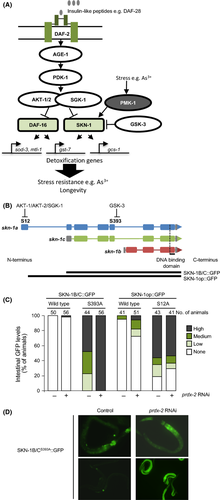
Results
PRDX-2 is required for insulin/IIS-dependent inhibition of SKN-1
Loss of prdx-2 increases the expression of SKN-1-regulated phase 2 detoxification genes, including gcs-1 that is important for resistance to arsenite (An & Blackwell, 2003; Liao & Yu, 2005; Olahova et al., 2008). Hence, to test whether the increased expression of these phase 2 genes in prdx-2-mutant animals might reflect increased SKN-1 activity, we examined the nuclear levels of SKN-1::GFP in animals treated with prdx-2 RNAi. The effect of prdx-2 RNAi was examined on transgenic lines containing arrays expressing different wild-type SKN-1::GFP isoforms. SKN-1B/C::GFP encodes both the SKN-1B and SKN-1C isoforms, whereas SKN-1op::GFP also encodes SKN-1A (Fig. 1B) (Tullet et al., 2008). Nuclear levels of SKN-1::GFP are barely detectable in the intestinal nuclei of animals maintained under normal conditions. However, prdx-2 RNAi caused SKN-1::GFP to be detected in intestinal nuclei of a small number of SKN-1B/C::GFP animals and significantly increased the number of SKN-1op::GFP animals containing nuclear SKN-1::GFP (Fig. 1C). This suggests that loss of PRDX-2 increases the activity of SKN-1, particularly the SKN-1A form (Tullet et al., 2008).
SKN-1 is positively regulated by PMK-1-dependent phosphorylation (Inoue et al., 2005) (Fig. 1A). Previously, we had shown that the arsenite-induced activation of PMK-1 was impaired in the prdx-2 mutant, ruling out increased PMK-1-mediated activation of SKN-1 as responsible for the increased SKN-1 activity in prdx-2-mutant animals (Olahova et al., 2008). However, SKN-1 is also negatively regulated by a number of mechanisms, including GSK-3- and AKT-1-/AKT-2-/SGK-1-mediated phosphorylation of specific serine residues (An et al., 2005; Tullet et al., 2008) (Fig. 1A,B). To determine whether the increased levels of SKN-1 in intestinal nuclei might be due to reduced insulin-dependent phosphorylation by AKT-1/SGK-1, or alternatively reduced phosphorylation by GSK-3, we compared the nuclear levels of mutant forms of SKN-1, SKN-1B/CS393A::GFP and SKN-1opS12A::GFP in which serines required for GSK-3- and insulin-mediated inhibition, respectively, are substituted with alanine (Fig. 1A,B) (An et al., 2005; Tullet et al., 2008). Consistent with previous work, SKN-1B/CS393A::GFP, that retains AKT/SGK sites but lacks the GSK-3 phosphorylation site, was detected in some (‘low’ and ‘medium’) or all (‘high’) intestinal nuclei in control animals (Fig. 1C,D) (An et al., 2005). However, SKN-1B/CS393A::GFP was present at high levels in every intestinal nucleus in prdx-2 RNAi-treated animals (Fig. 1C,D). This suggests that the inhibition of SKN-1 by PRDX-2 does not require GSK-3-mediated phosphorylation of SKN-1. In contrast, loss of PRDX-2 did not increase the nuclear levels of SKN-1opS12A::GFP in which a key IIS-inhibited phosphorylation site is substituted with alanine (Fig. 1B,C) (Tullet et al., 2008). This raised the intriguing possibility that PRDX-2 might reduce SKN-1 activity by promoting the IIS-dependent inhibition of SKN-1 (Fig. 1A).
PRDX-2 is required for insulin secretion
To determine whether the increased nuclear SKN-1 levels in PRDX-2-deficient animals reflected reduced insulin signalling, we began by testing whether loss of PRDX-2 affected the release of insulin ligands. Under favourable conditions, the insulin-like neuropeptide DAF-28 is highly expressed and acts as a DAF-2 receptor agonist, increasing IIS activity. To determine the ability of prdx-2 mutants to secrete insulin under well-fed conditions, we employed a strain expressing DAF-28::GFP. In well-fed animals, DAF-28::GFP is secreted from the ASJ and ASI neurons into the pseudocoelom from which it acts as a ligand for the insulin receptor, DAF-2, promoting IIS in many tissues (Fig. 1A) (Kao et al., 2007). Caenorhabditis elegans contains six macrophage-like scavenging cells (coelomocytes) that continuously take up the pseudocoelomic fluid (Fares & Greenwald, 2001a). Hence, the GFP fluorescence intensity in coelomocytes has been established as a reliable in vivo measure of the secretion of GFP-tagged neuropeptides, including DAF-28::GFP, in intact animals (Fares & Greenwald, 2001a). Loss of PRDX-2 does not have the strong larval arrest phenotype associated with mutants in which insulin secretion is severely impaired (Kao et al., 2007). Nevertheless, 30% of prdx-2-mutant animals expressing DAF-28::GFP lacked any GFP-positive coelomocytes and only 35% of prdx-2-mutant animals contained more than one coelomocyte with detectable GFP flu-orescence (Fig. 2A). In contrast, at least two GFP-positive coelomocytes were easily detected in every wild-type DAF-28::GFP animal (Fig. 2A). Moreover, quantification revealed a significant decrease in the intensity of DAF-28::GFP fluorescence in GFP-positive coelomycetes in prdx-2-mutant animals compared with wild-type animals (Fig. 2B,C). Importantly, loss of PRDX-2 did not reduce the levels of a muscle-expressed, secretion-targeted GFP (ssGFP) that accumulated in coelomocytes (Fig. S1A, Supporting information). This indicates that the lower levels of DAF-28::GFP present in PRDX-2-deficient coelomocytes (Figs 2 and S1B) do not reflect a general impairment in protein secretion or defective coelomocyte endocytosis. It was possible that the reduced insulin secretion reflected lower levels of insulin synthesis in prdx-2-mutant worms. However, the intensity of DAF-28::GFP in the neurons of control and PRDX-2-deficient animals was similar (Fig. S2A,B). Moreover, there was no reduction in the total levels of DAF-28::GFP protein detected by immunoblotting (Fig. S2C). Together, these data strongly suggest that PRDX-2 is required for the normal neuronal secretion of DAF-28::GFP into the pseudocoelom.
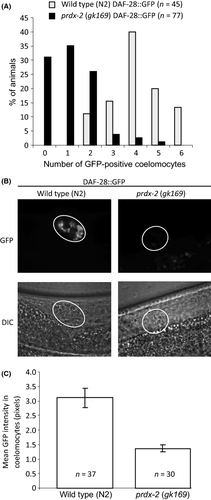
Loss of PRDX-2 increases arsenite resistance by increasing both SKN-1 and DAF-16 activities
Like SKN-1, the FOXO transcription factor DAF-16 is also inhibited by IIS-dependent phosphorylation (Fig. 1A). In wild-type animals, DAF-16 is normally maintained in the cytoplasm by inhibitory phosphorylation from the IIS-activated AKT kinases that are activated downstream of AGE-1 and PDK-1 (Fig. 1A). Hence, to test whether loss of PRDX-2 also increased DAF-16 activity, we examined the localization of GFP in transgenic wild-type and prdx-2-mutant animals expressing DAF-16::GFP (Lin et al., 2001). Although smaller than the increase observed in age-1-mutant animals, there was a significant increase in the nuclear localization of DAF-16::GFP in prdx-2-mutant animals (Fig. 3A). Consistent with increased DAF-16 activity, qRT–PCR analysis confirmed that the endogenous expression of several DAF-16-activated genes (mtl-1, sod-3, gst-7) (Murphy et al., 2003) was increased in prdx-2-mutant animals (Fig. 3B and Table S1, Supporting information). A sod-3p::gfp reporter was also upregulated in prdx-2 RNAi-treated animals in a manner that was partly dependent on DAF-16 (Fig. S3). Moreover, prdx-2 RNAi failed to increase the arsenite resistance of daf-16-mutant animals, suggesting that DAF-16 is required for the increased arsenite resistance associated with loss of prdx-2 (Fig. 3C). However, reduced IIS and loss of PRDX-2 also increase the SKN-1 activity (Tullet et al., 2008) (Fig. 1), which also activates gst-7 (Oliveira et al., 2009) and other genes, such as gcs-1, that are important for resistance to arsenite (Liao & Yu, 2005; Oliveira et al., 2009). Indeed, the increased arsenite resistance associated with the loss of PRDX-2 is also partially dependent on SKN-1 (Fig. 3D) (Olahova et al., 2008). Together, these data suggest that elevated DAF-16 and SKN-1 activities mediate the increased arsenite resistance of prdx-2-mutant animals.

Reduced IIS-dependent inhibition of DAF-16 and SKN-1 is sufficient to explain the increased arsenite resistance associated with loss of PRDX-2
To determine whether reduced insulin signalling was sufficient to fully explain the increased arsenite resistance associated with loss of PRDX-2, we examined whether loss of prdx-2 affected the arsenite resistance of daf-2 (e1370)-mutant animals. The daf-2 (e1370) allele encodes a less active form of the insulin receptor (DAF-2), the function of which is further reduced at 25 °C (Gems et al., 1998). As expected, consistent with reduced DAF-2 activity and increased activity of DAF-16 and SKN-1, daf-2 (e1370) animals were hyper-resistant to arsenite-induced stress (Fig. 4). Moreover, loss of PRDX-2, by RNAi or loss of gene function (gk169), did not cause a further increase in the expression of a sod-3p::gfp transgene (Fig. S3D) or the arsenite resistance of daf-2 (e1370)-mutant animals (Fig. 4). Thus, the increased sod-3p::gfp expression and arsenite resistance associated with loss of PRDX-2 (Figs 3C,D, 4 and S3) (Olahova et al., 2008) are dependent on normal levels/activity of the insulin receptor. This is consistent with the underlying defect in DAF-28::GFP secretion, and derepression of DAF-16 and SKN-1, being responsible for the increased arsenite resistance of prdx-2-mutant animals. Notably, daf-2-mutant animals were more resistant to arsenite than prdx-2-mutant animals, suggesting that further derepression of DAF-16 and SKN-1 in these animals might cause a more substantial increase in stress resistance. However, the small, but insignificant, decrease in the arsenite resistance of daf-2 (e1370) animals lacking PRDX-2 raises the possibility that the arsenite-protective function of intestinal PRDX-2 (Olahova et al., 2008) might also contribute to the increased arsenite resistance of daf-2 (e1370).
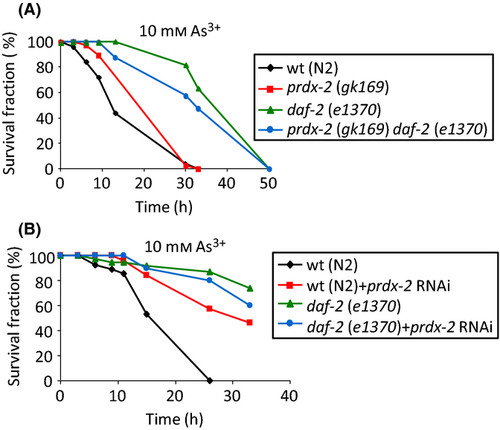
Further reductions in IIS are required for dauer formation and increased fat storage in prdx-2-mutant animals
In addition to the increased stress resistance, lower levels of IIS have profound effects on C. elegans development and metabolism. For example, another DAF-16-mediated effect of reduced IIS is increased fat storage (Ogg et al., 1997; Perez & Van Gilst, 2008). Notably, the reduction in IIS associated with loss of prdx-2 was insufficient to increase fat accumulation. Importantly, although prdx-2 (gk169)-mutant animals contained normal levels of fat, the high fat levels in daf-2 (e1370) prdx-2 (gk169) double mutants were similar to those observed in daf-2 (e1370) at 15 °C (Fig. S4), indicating that PRDX-2 is not required for the increased fat synthesis associated with loss of IIS. This suggested that further changes in IIS might be required to increase fat storage.
Insulin signalling also plays an important part in inhibiting dauer formation. The dauer state is a stress-resistant alternative larval form that is induced by dauer pheromone under stressful conditions, such as when animals are overcrowded. When animals containing the daf-2 (e1370) temperature-sensitive allele are maintained at the nonpermissive temperature (25 °C), the increased DAF-16 activity causes induction of dauer even when food is plentiful (Table 1) (Henderson & Johnson, 2001; Lee et al., 2001; Lin et al., 2001). Importantly, prdx-2-mutant animals bearing the daf-2 (e1370) allele still entered dauer at 25 °C (Table 1), indicating that PRDX-2 is not required for dauer formation. However, despite the increased activity of DAF-16 in prdx-2-mutant animals, no dauer animals were observed under normal growth conditions at 15, 20 or 25 °C (data not shown and Table 1). At 27 °C, a small proportion of wild-type animals undergo transient dauer formation (< 1%), even when food is plentiful (Ailion & Thomas, 2000). prdx-2-mutant animals develop more slowly than wild-type at temperatures above 15 °C (Isermann et al., 2004 and our unpublished observations). This, coupled with the asynchrony of development and transient nature of dauer formation at 27 °C (Ailion & Thomas, 2000), made it difficult to quantitatively compare dauer formation in wild-type and prdx-2-mutant animals at 27 °C in a reliable way. However, consistent with increased DAF-16 activity in prdx-2-mutant animals augmenting the induction of dauer at higher temperatures (Ailion & Thomas, 2000), there appeared to be a small increase in the proportion of prdx-2-mutant animals that formed dauer at 27 °C. Nevertheless, in contrast to mutants in IIS pathway components, less penetrant than daf-2 (e1370) but constitutively dauer at 27 °C e.g. akt-1 (mg306) (Ailion & Thomas, 2003; Hu et al., 2006), the vast majority (309 of 318) of prdx-2-mutant animals still proceeded to adulthood at 27 °C.
| Strain | 25 °C | 20 °C | ||||
|---|---|---|---|---|---|---|
| Adults | Dauers | % Dauer | Adults | Dauers | % Dauer | |
| Wild-type (N2) | 110 | 0 | 0 | 402 | 0 | 0 |
| prdx-2 (gk169) | 167 | 0 | 0 | 541 | 0 | 0 |
| daf-2 (e1370) | 0 | 137 | 100 | 230 | 6 | 2.54 |
| prdx-2 (gk169) daf-2 (e1370) | 0 | 137 | 100 | 545 | 27 | 4.72 |
| Wild-type (N2) vector | 99 | 0 | 0 | – | – | – |
| Wild-type (N2) prdx-2 RNAi | 101 | 0 | 0 | – | – | – |
| akt-1 (mg306) vector | 311 | 2 | 0.64 | – | – | – |
| akt-1 (mg306) prdx-2 RNAi | 120 | 9 | 7.5 | – | – | – |
However, when we examined the effect of loss of prdx-2 on mutants in which IIS is reduced, we did observe a slight increase in the number of dauers formed by daf-2 (e1370) mutants at 20 °C (Table 1). Furthermore, although loss of akt-1 function does not reduce IIS sufficiently to constitutively induce dauer formation until temperatures are raised to 27 °C (Ailion & Thomas, 2003; Hu et al., 2006), a significantly increased proportion of prdx-2 RNAi-treated akt-1-mutant animals underwent dauer formation at 25 °C (Table 1). Taken together, these data suggest that loss of PRDX-2 reduces IIS and increases DAF-16 and SKN-1 activities sufficiently to increase arsenite resistance, but that further reductions in IIS are required to increase fat storage or induce dauer formation.
PRDX-2 is required for the lifespan-extending effects of reduced insulin signalling
Following seminal discoveries in C. elegans (Kenyon et al., 1993), it is now well established that reduced insulin signalling is able to delay age-associated declines in tissue function and produce considerable lifespan extensions in animals (Clancy et al., 2001; Bluher et al., 2003; Holzenberger et al., 2003). The increased stress resistance of C. elegans with reduced insulin signalling is associated with substantial increases in lifespan that are dependent on DAF-16 and SKN-1 (Lin et al., 2001; Tullet et al., 2008). In contrast, despite the increased activity of DAF-16 and SKN-1 and resistance to arsenite, at 15 °C, loss of PRDX-2 causes a dramatic shortening of lifespan as a result of accelerated ageing (Olahova et al., 2008) (Fig. 5, Table S2). Indeed, although daf-2 (e1370)-mutant animals were long-lived at 15 °C, this increase in lifespan was largely ablated by prdx-2 RNAi (Fig. 5A). Importantly, prdx-2 RNAi did not reduce the lifespan of long-lived C. elegans that harbour a mutation in cytochrome c reductase cyc-1, an important component of the electron transport chain. This indicates that loss of PRDX-2 does not lead to a general sickness or limit lifespan at 15 °C (Fig. S5). Hence, these data suggest that, although loss of PRDX-2 increases DAF-16 and SKN-1 activities (Figs 1C,D and 3A,B) and arsenite resistance (Figs 3C,D and 4) at 15 °C, PRDX-2 is required for the full extension in lifespan associated with reduced insulin signalling at this temperature.

It was possible that PRDX-2 was important for the increased lifespan-promoting activity of nuclear DAF-16 at 15 °C or, alternatively, acted independently to increase the lifespan. To distinguish between these possibilities, we examined whether PRDX-2 was required for the lifespan extension associated with a gain of function in the SGK-1 kinase that increases the lifespan in a DAF-16-dependent manner (Chen et al., 2013). Our discovery that PRDX-2 was essential for the increased longevity associated with the sgk-1 gf allele suggested that PRDX-2 acts downstream or independently from SGK-1 to increase lifespan (Fig. 5B).
The transcription factor, heat-shock factor, HSF-1, coregulates many DAF-16 targets and is also important for the increased lifespan associated with reduced IIS (Hsu et al., 2003; Morley & Morimoto, 2004; Seo et al., 2013). Hence, it was possible that the failure of decreased IIS or sgk-1 gain of function to increase the lifespan of PRDX-2-deficient animals might reflect lower levels of HSF-1 activity in these animals. However, although transgenic overexpression of hsf-1 increased the lifespan at 15 °C, it failed to increase the lifespan of PRDX-2-deficient animals (Fig. 5C). Although the basis of PRDX-2's essential prolongevity function is unknown, together, these data suggest that PRDX-2 acts independently of IIS to promote increased longevity at 15 °C.
Collectively, these data suggest that the increased intestinal activity of DAF-16 and SKN-1 and arsenite resistance associated with loss of PRDX-2 may be due to impaired insulin secretion (Fig. 6). Nevertheless, our data reveal that further reductions in IIS and increases in DAF-16 activity are required for the reprogramming of metabolism and development (Fig. 6). Moreover, our data suggest that although increased DAF-16 and SKN-1 activities are able to increase tolerance to an acute stress, their prolongevity activities are unable to fully compensate for the life-shortening effect of loss of PRDX-2 at 15 °C (Fig. 6).
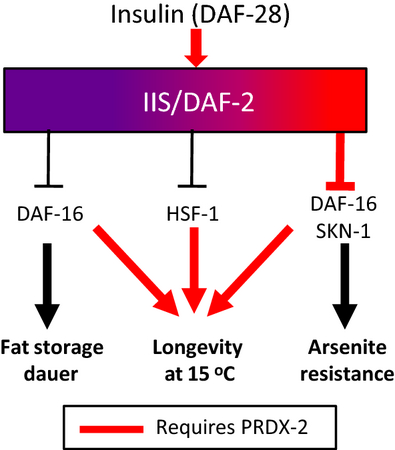
Discussion
Peroxiredoxins are abundant peroxidases that have also been shown to regulate the activity of multiple signalling pathways by stimulating or inhibiting the oxidation of redox-sensitive signalling proteins (Rhee & Woo, 2011). Here, we have identified a new role for the C. elegans orthologue of the tumour suppressor Prdx1 in signal transduction through insulin-signalling pathways. We reveal that under nutrient-rich conditions, PRDX-2 promotes IIS by promoting the secretion of the insulin peptide DAF-28.
With increases in type 2 diabetes and cancer associated with deregulated insulin signalling, there is substantial interest in therapeutically manipulating insulin-signalling pathways. It is widely appreciated that ROS have both negative and positive roles in insulin responses (Szypowska & Burgering, 2011). For example, the transient inactivation of the phosphatase PTEN by ROS-induced oxidation has been demonstrated to play an important role in regulating the activity of kinases that participate in the IIS-dependent inhibition of FOXO (Leslie et al., 2003). Cytosolic peroxiredoxins have been shown to play an important role in modulating the inactivation of these phosphatases in cultured cells. For example, previous work in mouse cells has suggested that loss of Prdx1 promotes the oxidative inactivation of PTEN and increases Akt activity (Cao et al., 2009). Similarly, Prx have also been shown to provide a barrier to the ROS-mediated inactivation of protein tyrosine phosphatases (PTP) during growth factor signalling (Choi et al., 2005). These studies in cellular models have revealed several mechanisms by which different peroxiredoxin activities could prevent or promote age-associated diseases, such as diabetes and cancer. For example, by protecting the PTP and PTEN phosphatases from ROS-mediated inactivation, human Prx may provide an important barrier to inappropriate oncogenic signalling (Choi et al., 2005; Cao et al., 2009). However, Akt kinases also mediate insulin signalling; thus, reduced PTEN or PTP1B activity would be predicted to increase insulin/IGF-1-like signalling. The discovery that a Prx is important for insulin secretion reveals that systemically reducing Prx function may have more complex effects on the insulin-mediated responses of a whole animal than suggested by studies in cell models.
Although it remains to be determined why PRDX-2 is required for normal levels of insulin secretion, it is possible that increased levels of ROS, due to loss of the peroxidase activity of PRDX-2, may inhibit DAF-28::GFP secretion. Consistent with this, the ROS generator, methyl viologen, also inhibits DAF-28::GFP secretion (O. Billing & G. Kao, personal communication). Moreover, changes in the cellular redox environment are also important for the glucose-stimulated release of insulin in mammals (Ivarsson et al., 2005; Rebelato et al., 2011). Thus, it is possible that the role of PRDX-2 in insulin release could be shared by mammalian Prx. Together, these data suggest that impaired insulin release, and the resulting decrease in IIS, could contribute to the hormetic effects of some stress treatments. Nevertheless, misregulation of IIS can also have a widespread and devastating effect on many cellular functions. For example, high glucose has been shown to reduce C. elegans lifespan (Lee et al., 2009b; Schlotterer et al., 2009). Accordingly, the impaired insulin secretion in prdx-2-mutant C. elegans also raises the possibility that a reduced ability to promote glucose uptake may contribute to their reduced lifespan.
The effect of loss of PRDX-2 on DAF-28::GFP secretion is comparable to the reported effects of RNAi targeting asna-1 or mitochondrial components, which have previously been shown to be important for insulin secretion (Figs 2 and S1) (Kao et al., 2007; Billing et al., 2011). However, in contrast to loss of asna-1 or mitochondrial function, for example tomm-20, there is no larval arrest/constitutive dauer phenotype associated with loss of PRDX-2 function. The effect of complete loss of ASNA-1 or mitochondrial function on insulin secretion cannot be quantitated, given the necessity of measuring DAF-28::GFP secretion in adult animals. Hence, it remains possible that the absence of a larval arrest/dauer phenotype associated with loss of PRDX-2 is due to the fact that loss of PRDX-2 does not impair DAF-28::GFP secretion as much as complete loss of ASNA-1 or TOMM-20 function. Alternatively, as discussed below, it could indicate a more specific function for PRDX-2 in the secretion of a particular subset of insulin-like peptides.
The C. elegans genome encodes 40 insulin-like proteins that are together involved in the regulation of longevity, stress resistance, metabolism or dauer entry and exit (Li et al., 2003; Cornils et al., 2011; Ritter et al., 2013; Fernandes de Abreu et al., 2014; Hung et al., 2014). Indeed, it is possible that the increased stress resistance of prdx-2-mutant animals reflects impaired secretion of other insulin-like proteins, in addition to DAF-28. DAF-28 inhibits dauer formation and is significantly reduced in dauer stage animals (Li et al., 2003). The absence of dauer prdx-2-mutant larvae under favourable growth conditions suggests that either secretion of DAF-28 or other insulin-like proteins, such as INS-4 and INS-6 that act together with DAF-28 to inhibit dauer arrest (Cornils et al., 2011; Fernandes de Abreu et al., 2014; Hung et al., 2014), remain sufficient in these animals to suppress the dauer developmental programme under these conditions. It is intriguing that despite impaired secretion of DAF-28 and reduced IIS activity, further changes in IIS are required in order for PRDX-2-deficient animals to undergo dauer development or increased fat synthesis. Recent studies suggest functional redundancies between insulins are common (Ritter et al., 2013). Therefore, it is possible that, although DAF-28 secretion is impaired in PRDX-2-deficient animals, levels of other insulins are unaffected and/or sufficient to repress dauer formation and fat metabolism.
Although the increased activity of SKN-1 and DAF-16 in prdx-2-mutant animals results in increased stress resistance, our data suggest that PRDX-2 is important for the full life-extending effects of increased SKN-1 and DAF-16 activities. By genetically separating the increased stress resistance associated with increased SKN-1 and DAF-16 activities from their longevity-promoting effects, this provides evidence that the increased stress resistance associated with reduced IIS is not sufficient to increase lifespan. Adaptive, stress-protective, responses may mediate the lifespan extension associated with low levels of ROS (Doonan et al., 2008; Yang & Hekimi, 2010; Zarse et al., 2012; Martins et al., 2014). However, our study supports others, which suggest that the ability to survive an acutely toxic stress does not necessarily correlate with increased lifespan (Doonan et al., 2008; Van Raamsdonk & Hekimi, 2012). Understanding the interplay between ROS, signal transduction and ageing in a whole animal is challenging. Our discovery that a peroxiredoxin promotes the release of insulin from neurons to increase the expression of stress defences in other tissues exemplifies the importance of whole animal studies as a vital complement to studies in cellular models.
Experimental procedures
Caenorhabditis elegans strains
All animals were maintained at 15 °C unless stated otherwise on NGM-Lite agar plates using standard methods. For details of the strains used in this study, please see Data S1 (Supporting information).
Sodium arsenite sensitivity assays
Approximately 35 well-fed L4 larval stage hermaphrodites were transferred to freshly made NGM-Lite agar plates containing 10 mm sodium arsenite. A ‘pickful’ of OP50 bacteria was transferred to the middle of the plate, and the animals were incubated at 15 °C. The number of dead worms was scored at the indicated time points. Worms that did not respond to a gentle prodding or lacked pharyngeal pumping were scored as dead and removed from the plate. Log-rank survival analysis (Minitab Inc., State College, PA, USA) was used to determine statistically significant differences between groups.
RNAi
Escherichia coli HT115 containing pL4440 (vector control) or pL4440 containing the prdx-2 or daf-2 orf were grown overnight at 37 °C to OD600 = 1.0 in LB liquid media containing 50 μg mL−1 ampicillin (SIGMA-ALDRICH, Poole, UK). 1.0 mm Isopropyl β-D-?1-?thiogalactopyranoside (IPTG) was added to the cultures used to seed RNAi plates [0.3% (w/v) NaCl, 1.7% (w/v) agarose, 0.25% (w/v) bactopeptone, 0.08% (w/v) yeast extract, 1.0 mm CaCl2, 1.0 mm MgSO4, 2.5 mm phosphate buffer (pH 6.0), 1.0 mm IPTG, 5.0 μg mL−1 cholesterol and 60 μg mL−1 ampicillin]. Plates were incubated at room temperature for 2 days before use. In Figs 3C,D and 4B, RNAi was carried out by microinjection of dsRNA as previously described (Olahova et al., 2008).
Microscopy
Animals were mounted on a 3% agarose pad, anaesthetized with 0.06% levamisole, unless otherwise indicated, and microscopic observations were made using a Zeiss Axioskop 2 (Carl Zeiss Ltd, Welwyn Garden City, UK) or Axiovert microscope (40 or 63× objective lens). GFP was detected by excitation with wavelengths 450–490 nm, and all the images were acquired using axiovision software version 3.1.2.1 (Carl Zeiss Ltd, Welwyn Garden City, UK).
Analysis of DAF-16 activation
The subcellular localization of DAF-16 was determined in L2/L3 larval stage N2 [DAF-16a::GFP], prdx-2 (gk169) [DAF-16a::GFP] and age-1 (hx546) [DAF-16a::GFP] transgenic animals using a Zeiss Axioskop 2 fluorescent microscope. The DAF-16::GFP localization was scored as cytosolic, intermediate and nuclear depending on major localization of the DAF-16::GFP fusion protein. Images were acquired using axiovision software. Chi-square test (Microsoft Excel) was used to determine statistically significant differences between groups.
Analysis of levels of SKN-1 in intestinal nuclei
To examine the intestinal expression of SKN-1B/C::GFP or SKN-1op::GFP, SKN-1B/CS393A::GFP or SKN-1opS12A::GFP, approximately ten late L4 larval stage animals were transferred to fresh RNAi plates. The F1 progeny produced was scored at L2/L3 larval stage under Zeiss Axioskop 2 fluorescent microscope for the GFP expression in the intestine. Worms were maintained at 15 °C and scored none, low, medium or high, depending on the number of intestinal nuclei in which GFP was visible. ‘None’ refers to no intestinal GFP expression. ‘Low’ indicates that the intestinal GFP expression is present anteriorly, or anteriorly and posteriorly (≤ 7 nuclei). ‘Medium’ indicates GFP expression is present anteriorly and posteriorly in some but not all intestinal nuclei (> 7). ‘High’ refers to animals in which GFP was detectable throughout most of the intestine. Statistically significant differences between groups (P-values) were calculated using a chi-square test (Microsoft Excel).
RNA extraction and quantitative RT–PCR
RNA was extracted from approximately 3000 well-fed age-synchronized wild-type (N2) and prdx-2 (gk169) young adult animals using Trizol (Sigma). The RNA samples were DNaseI treated (Ambion and PrimerDesign Life Technologies, Thermofisher Scientific, Waltham, MA, USA) according to the manufacturer's instructions and used immediately in the qRT–PCR. Supercript III Platinum SYBR Green One-Step qRT–PCR kit (Invitrogen) or Precision OneStep qRT PCR MasterMix (PrimerDesign) and Corbett Life Science (Qiagen, Crawley, UK) Rotor-Gene 6000 system were used to determine relative levels of gst-7, mtl-1 and sod-3 gene expression. mRNA levels of act-1 were used for normalization. A Student's t-test was used to test the statistical significance of differences. Primer sequences are available on request.
Lifespan analysis
Approximately 15 late L4 larval stage animals were transferred to fresh RNAi plates. The lifespan of F1 progeny produced after approximately 24 h was assessed. Adult hermaphrodites were transferred away from their progeny to a fresh plate every second day until they stopped laying eggs. The lifespan assays were conducted at 15 °C. The viability of each worm was assessed from either L1 larval stage or adulthood. Worms that did not move after repeated prodding with a pick or lacked pharyngeal pumping were scored as dead and removed from the plate. A log-rank survival test (minitab 16) was used to determine whether differences between groups were statistically significant.
Dauer assay
Approximately 25 young adult animals were allowed to lay eggs for 3 h at 15 °C. The adults were removed, and the eggs were incubated at the indicated temperatures (Table 1) for 48 h before dauer formation was scored under a Leica S6 stereomicroscope (Leica, Wetzlar, Germany).
Analysis of DAF-28::GFP secretion
To assess the secretion of the insulin-like protein DAF-28::GFP from neurons or ssGFP from muscles, the intensity of GFP fluorescence was measured in coelomycetes in 1-day-old adult animals expressing DAF-28::GFP (Kao et al., 2007) or ssGFP (Fares & Greenwald, 2001a,b) using a Zeiss Axioskop 2 microscope with excitation at 450–490 nm. Animals were mounted onto microscope slides containing 2% agarose and anesthetized with 0.06% levamisole. All images were taken under the 63× objective lens and captured at the same exposure. The number of coelomocytes in each animal containing visible levels of GFP was scored, and the amount of GFP fluorescence in GFP-positive coelomocytes was quantified using axiovision 3.1.2.1 software. A defined area (± 10%) of a coelomocyte was outlined in each animal, and the mean pixel value and standard error were calculated (Kao et al., 2007). A Student's t-test was used to test the statistical significance of differences.
Acknowledgments
We are grateful to Ola Billing and Gautam Kao for sharing unpublished data. We also thank Viktor Korolchuk, Antonio Miranda-Vizuete, Daryl Shanley, Jennifer Tullet and David Weinkove for comments on the manuscript and Keith Blackwell, David Weinkove, Antonio Miranda-Vizuete and Gautam Kao for strains and advice. Technical assistance was provided by Michelle Wray.
Funding
Some strains were provided by the CGC, which is funded by NIH Office of Research Infrastructure Programs (P40 OD010440). This work was funded by MRC grant G0800082.
Conflict of interest
None declared.
Author contributions
MO and EV designed the experiments, MO and EV carried out the experiments and analysed the data, and MO and EV wrote the manuscript.




